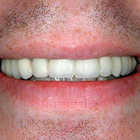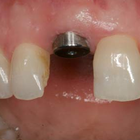Dental Implant in Philippines
Search and Compare the Best Clinics and Doctors at the Lowest Prices for Dental Implant in Philippines

Find the best clinics for Dental Implant in Philippines
With Medijump you can browse 5 facilities offering Dental Implant procedures in Philippines. The cheapest price available is $1,079 in Metro Manila. And for the cheapest price globally, prices start from $1 in Vietnam.
Dental Implant in Metro Manila
Price: $ 1,079
Vietnam offers the best prices Worldwide
Price: $ 1
From 4 verified reviews
Emem Valdez, 26 August 2020
If you are looking for a dental clinic with utmost care for their patients' comfort Cillo Smile Design is your best bet. The whole feel of the place was very welcoming. My experience with Dr. Angelica Cillo and her assistant was superb. She …
From 3 verified reviews
Jethro L., 09 September 2020
so far after 2 sessions with doctor Maximo my gums are getting better. a Service with care Thank you so much Doc
From 93 verified reviews
Steve Frost, 20 September 2020
Best hospital in delhi ncr. Good quality of treatment and takes good care of patients.
Alora Dental Clinic, located in Marikina, Metro Manila, Philippines offers patients Dental Implant procedures among its total of 14 available procedures, across 1 different specialties. The cost of a Dental Implant procedure ranges from ₱80,000 to ₱160,000, whilst the national average price is approximately ₱66,253. All procedures and treatments are undertaken by just a small team of specialists, with 2 in total at the Dental, and they are not accredited by any recognized accreditations institutes
Citimedic Specialty Clinic and Laboratory, located in Tuguegarao, Cagayan, Philippines offers patients Dental Implant procedures among its total of 63 available procedures, across 8 different specialties. Currently, there's no pricing information for Dental Implant procedures at Citimedic Specialty Clinic and Laboratory, as all prices are available on request only, whilst the national average price is approximately ₱66,253. There are many specialists available at the Clinic, with 4 in total, and they have multiple recognized accreditations, including: PSO-HNS - Philippine Society of Otolaryngology Head & Neck SurgeryPAFPARS - Philippine Academy of Facial Plastic Aesthetic and Reconstructive Surgery
- Home
- Philippines
Compare Before & After Photos of _procedure_photos.phpDental Implant


Front view


Front view


Front view


Front view


Front view
WHY US?
At Medijump, we're making medical easy. You can search, compare, discuss, and book your medical all in one place. We open the door to the best medical providers worldwide, saving you time and energy along the way, and it's all for FREE, no hidden fees, and no price markups guaranteed. So what are you waiting for?

Free

Best Price

Widest Selection

Risk-Free
What you need to know about Dental Implant in Philippines

A dental implant is a medical device that provide support to artificial teeth. It's surgically placed into the jaw to act as a replacement for the root of a missing or damaged tooth, which in turn serves to hold a replacement tooth or bridge. It functions and looks much like a real tooth, restoring your ability to chew and improves your overall appearance. Dental implant surgery is considered as a better alternative to dentures or bridgework that does not fit well. It also offers a great option for people when they do not have enough natural teeth roots left to build denture or bridgework replacements.
Since dental implants eventually fuse with your jawbone over the span of several months, it won’t make noise, slip, or cause bone damage the way dentures or bridgework might. Dental implants also enable natural speech, look and feel like your own teeth, make eating easier, and improves your appearance. However, the surgery may involve several stages, and, in some cases, it may require two separate visits to the clinic to complete. Ensure to look for a specialist in a reputable clinic for the best results.
What is the cost of Dental Implant in Philippines?
Price differences abound in Philippines for Dental Implant based on the clinic, the proficiency of the surgeon, and the individual requirements of the patients. It's essential to realize that dental insurance usually doesn't cover the entire bill for this treatment, though it might cover a part. Several dental clinics provide finance schemes or payment alternatives to assist in easing the financial burden. For more precise cost estimates, reach out to your dental service provider or a nearby clinic.
What does a Dental Implant Procedure Involve?
Dental implant surgery generally requires several stages. Each stage may be performed under general or local anesthetic. The first stage is removing the damaged tooth. Then, if your jawbone is too soft or not thick enough, your dentist may perform bone grafting to create a more solid base for the implant. The bone graft may be natural (taken from another part of your body) or synthetic (a bone-substitute material). If you only need minor bone grafting, the implant surgery can be performed on the same day. However, if you need a significant amount of bone graft, the implant surgery may have to be postponed until the transplanted bone grows enough new bone to support the dental implant.
The next stage after the damaged tooth removal and bone graft (if you need one) is placing the dental implant. To do this, your dentist makes an incision to expose the bone and puts the metal implant post deep into the bone. At this stage, you will still have a gap where your tooth is missing. Your dentist will place a temporary denture for appearance. Once the metal implant post is placed, osseointegration begins. This is a process where the jawbone grows into the surface of the implant and can take several months to complete. After osseointegration is complete, your dentist will place the abutment, which is a small connector post that will hold your new tooth. The final stage, after the abutment is placed, is placing the crown, which is the tooth-looking part. You can choose between a removable crown and a fixed crown.
How Long Should I Stay in Philippines for a Dental Implant Procedure?
The length of your stay in Philippines for a Dental Implant depends on numerous considerations like the intricacies of the procedure, the quantity of implants required, and your personal recovery process. Each stage of dental implant surgery is done in separate appointments. After each appointment, you should be able to leave the hospital or clinic right away. However, you should stay in Philippines for at least 2 weeks for completion of the work, the initial recovery time, and follow-up checkups.
What's the Recovery Time for Dental Implant Procedures?
The recuperation duration following a Dental Implant or dental implant operation can widely vary and is shaped by multiple aspects. Initial healing of the tissue might require only a handful of days, but complete osseointegration (the fusion of the implant with the jawbone) generally spans several months. This window could be extended for patients requiring auxiliary procedures such as bone grafts, or those with prevailing health issues that may impede the healing process.
Post-procedure, it's not unusual to experience a degree of discomfort, which could manifest as minor pain, swelling of your gums and face, skin and gum bruising, and slight bleeding. Such symptoms are a standard phase of the recovery process and should alleviate within a fortnight. In this interim, it's advisable to stick to a soft diet to not overload the implant site with undue pressure. Any strenuous physical exertion should be put off to circumvent potential complications.
Maintaining excellent oral hygiene is paramount to facilitate healing and stave off infection. Regular brushing and flossing, being particularly gentle around the surgical area, coupled with rinsing your oral cavity with warm saline water, can contribute to keeping the region hygienic.
What sort of Aftercare is Required for Dental Implant Procedures?
After each stage of surgery, you may have to eat soft foods. Since you may experience swelling, bruising, pain, and minor bleeding, your dentist will prescribe pain medications or antibiotics to help ease your discomfort. During your recovery period, you need to avoid smoking as it can contribute to implant failure and complications.
No special care is required for dental implants. Nonetheless, you need to practice good oral hygiene in order to maintain the implant and your remaining natural teeth. Make sure to brush your teeth twice a day, floss daily, and rinse your mouth with an antiseptic mouthwash. You also need to see your dentist regularly and avoid damaging habits, such as chewing hard items.
What's the Success Rate of Dental Implant Procedures?
The efficacy of Dental Implant, alternatively referred to as dental implants, in Philippines, is typically impressive, boasting effectiveness percentages as high as 98% in some studies. This positions dental implants as one of the most reliable procedures within dental care's realm. Nevertheless, it's worth mentioning that the success rates might fluctuate, influenced by several factors.
The patient's overall health is a key determinant of the thriving outcome of a dental implant procedure. Individuals exhibiting optimal health usually witness higher success rates. Pre-existing health issues like diabetes, osteoporosis, and periodontal ailments can theoretically impact the efficacy of the implant.
Additional contributing factors to the success rate encompass the quality and abundance of the individual's bone structure. Patients boasting plentiful, healthy bone are ordinarily the perfect candidates for dental implants. However, those who have experienced bone loss might need to undergo a bone grafting procedure before the implant procedure. This step can provide a robust base for the implant and enhance the chances of a successful result.
Are there Alternatives to Dental Implant Procedures?
If you are not a candidate for dental implant surgery, or you simply do not want to undergo the procedure, you can opt for the alternatives. The alternatives include:
- Mini dental implants, which is a small type of dental implants. The structure is similar to regular dental implants, but are somewhat smaller in size. Unlike regular dental implants, dentists can often place mini implants only in one visit using local anesthesia. You may also be able to use your new teeth on the same day.
- A same-day implant is essentially similar to traditional dental implants. However, your dentist performs the whole process in just one day, skipping the process of wound healing and osseointegration.
- Implant-supported dentures or All-on-4 is an alternative if you need to fix a complete upper or lower set of teeth. During this procedure, four to six implants are placed into your jawbone as a base to attach and stabilize your denture.
What Should You Expect Before and After the Dental Implant Procedure?
Grasping what lies ahead before and post the Dental Implant can lessen potential worries and guarantee you are fully equipped for the upcoming journey. Prior to the procedure, your dental practitioner will conduct an all-inclusive dental assessment. This check-up may encompass dental X-rays and sophisticated 3D imaging to examine the status of your oral cavity.
The dental professional will also explore your medical history. If you're suffering from specific heart disorders or orthopedic implants, your dental practitioner might suggest antibiotics to avert infection. A personalized treatment blueprint, customized to your circumstances, will be constructed. This strategy takes into account factors like the amount of teeth you need substituted and the state of your jawbone. The procedure is typically carried out under local anesthesia to mitigate any discomfort.
Subsequent to the operation, experiencing slight unease is usual. You might witness inflammation of your face and gums, discoloration of your skin and gums, soreness at the insertion area, and insignificant bleeding. Your dental specialist will recommend medications to soothe these indicators. In case inflation, unease, or any other complications intensify in the days post-operation, it's crucial to reach out to your oral surgeon. Post-operation will require you to consume mushy foods as the operated site recovers. Moreover, you'll be guided to abstain from smoking, as it can hinder recovery and influence the triumph of the dental implant.
Following the positioning of the implant, the healing process, and fusion with the bone (osseointegration) transpire over an extended period. During this interval, maintaining robust oral cleanliness is vital. This involves frequent brushing, the use of dental floss, and cleansing with an antibacterial mouthwash. Periodic dental examinations are obligatory to track progress and confirm the well-being and effectiveness of the implant.
What are Potential Risks of Dental Implant?
Despite Dental Implant boasting remarkable effectiveness, it is, as any surgical operation, not without risks and potential difficulties. The chances of encountering these issues are often minute and irregularities are infrequent, yet it remains critical for patients to comprehend these possibilities before undertaking the procedure.
Complications and side effects may include:
- Implant failure
- Nerve injury
- Infection
- Sinus problems
- Damage to surrounding structures, such as other teeth or blood vessels
How long does a Dental Implant last?
The durability of a Dental Implant is heavily reliant on the individual's oral cleanliness and general wellbeing. Nonetheless, with appropriate upkeep and care, dental implants have the potential to stand the test of time. The titanium pillar inserted into the jawbone during surgery is crafted to be everlasting, while the dental cap fastened to the anchor may necessitate substitution every decade or decade and a half due to normal usage. Yet, with outstanding dental management and habitual screenings, the cap has the potential for lifelong endurance.
Whilst the information presented here has been accurately sourced and verified by a medical professional for its accuracy, it is still advised to consult with your doctor before pursuing a medical treatment at one of the listed medical providers
No Time?
Tell us what you're looking for and we'll reachout to the top clinics all at once
Enquire Now

Popular Procedures in Philippines
Prices Start From $1

Prices Start From $1

Prices Start From $48

Prices Start From $1

Prices Start From $1

Prices Start From $11

Prices Start From $1

Prices Start From $45

Recommended Medical Centers in Philippines for Dental Implant

- Interpreter services
- Translation service
- Religious facilities
- Medical records transfer
- Medical travel insurance
- Health insurance coordination
- TV in the room
- Safe in the room
- Phone in the room
- Private rooms for patients available

- Interpreter services
- Translation service
- Religious facilities
- Medical records transfer
- Medical travel insurance
- Health insurance coordination
- TV in the room
- Safe in the room
- Phone in the room
- Private rooms for patients available

- Interpreter services
- Translation service
- Religious facilities
- Medical records transfer
- Medical travel insurance
- Health insurance coordination
- TV in the room
- Safe in the room
- Phone in the room
- Private rooms for patients available

- Interpreter services
- Translation service
- Religious facilities
- Medical records transfer
- Medical travel insurance
- Health insurance coordination
- TV in the room
- Safe in the room
- Phone in the room
- Private rooms for patients available

- Interpreter services
- Translation service
- Religious facilities
- Medical records transfer
- Medical travel insurance
- Health insurance coordination
- TV in the room
- Safe in the room
- Phone in the room
- Private rooms for patients available

- Interpreter services
- Translation service
- Religious facilities
- Medical records transfer
- Medical travel insurance
- Health insurance coordination
- TV in the room
- Safe in the room
- Phone in the room
- Private rooms for patients available

- Interpreter services
- Translation service
- Religious facilities
- Medical records transfer
- Medical travel insurance
- Health insurance coordination
- TV in the room
- Safe in the room
- Phone in the room
- Private rooms for patients available

- Interpreter services
- Translation service
- Religious facilities
- Medical records transfer
- Medical travel insurance
- Health insurance coordination
- TV in the room
- Safe in the room
- Phone in the room
- Private rooms for patients available

- Interpreter services
- Translation service
- Religious facilities
- Medical records transfer
- Medical travel insurance
- Health insurance coordination
- TV in the room
- Safe in the room
- Phone in the room
- Private rooms for patients available

- Interpreter services
- Translation service
- Religious facilities
- Medical records transfer
- Medical travel insurance
- Health insurance coordination
- TV in the room
- Safe in the room
- Phone in the room
- Private rooms for patients available
Dental Implant in and around Philippines
About the Philippines
The Philippines is an island nation in the heart of Southeast Asia. It extends from the south of China to the northern tip of Borneo. It is also known as the ‘Pearl of the Orient Seas’, the Philippines is an archipelago of 7,107 islands. It comprises three main island groups, Luzon, Visayas, and Mindanao. Manila, the capital city, lies in the southwestern part of Luzon. Quezon City is the largest and most populous city in the country.
It is a prominent English-speaking country and was once a colony of Spain and the United States. It’s the most Westernised country in Asia. However, its culture is a mix of indigenous Malay culture and Spanish and American heritage.
Besides being one of the top tourist destinations, the Philippines is also an emerging medical tourism destination. It ranks in 8th position among popular medical tourism countries and more than 10,000 medical tourists visit the Philippines every year for various treatments. The following factors all contribute to the progress of medical tourism within the Philippines.
- Expert and board-certified medical professionals with international qualifications and training.
- Internationally-accredited hospitals with state-of-the-art medical equipment and modern facilities.
- Affordable costs compared to advanced nations
- Inexpensive accommodation
- The English language is widely-spoken making communication with the Medical team and patients easy.
- Tropical climate helps in the recovery and recuperation
The most common and popular procedures and treatments in the Philippines are cosmetic surgery, weight-loss surgery, dermatology, ophthalmology, and dentistry. As of late, people come here even for liver and kidney transplant surgeries, and cardiac surgeries due to the cost advantage it provides.
For example, a Breast Augmentation surgery that costs between $7,500-$8,500 in the US costs only between $3,000-$3,500 in the Philippines which would be a saving of about 58% to 60%. Also, a coronary artery bypass surgery costing $70,000-$133,000 in the US, will only cost between $11,500-$17,500 and would result in a saving of almost 83% to 86%. Even after adding travel and living expenses, it still makes it a, very good value for the patient to get medical care in the Philippines and several of the more popular Hospital and Clinics are located in Manila, and are St. Luke's Medical Center, Makati Medical Center, The Medical City and Asian Hospital and Medical Center
Popular Parts of the Philippines
The Philippines has a total land area of 116,000 square miles, with a large population of 107,791,044 million people. It has many pristine beaches, mountains, rainforests, islands, heritage towns, and monuments, With hotels, food, and transportation very affordable, it’s also a good budget tourism destination.
The following are some of the most beautiful places to visit in the Philippines:
- El Nido –is known for its white-sand beaches, clear turquoise waters, and coral reefs and is the gateway to the Bacuit archipelago which is a group of islands. The laid-back town of El Nido is a base for island-hopping tours, and kayaking trips to mountainous Cadlao Island, El Nido is situated on the northern edge of mainland Palawan.
- Coron – Is also situated in Palawan and is known for its warm waters, ideal for snorkeling, kayaking, and deep diving. The breathtaking Kayangan Lake, surrounded by karst walls is a visual treat. It is the cleanest lake in the Philippines.
- Tubbataha Reefs Natural Park –is also part of Palawan and is situated to the southeast, in the Sulu Sea. It’s home to countless coral reefs, and expansive breeds of fish, dolphins, sharks, and whales and It is a great water destination for divers.
- Banaue Rice Terraces – They lie within the mountainous region of the Cordilleras. The rice terraces are about 2,000 years old, a result of the labor of the predecessors of the region and They provide efficient space for people to farm on.
- Intramuros – The walled historical area of Manila contains the remains of a bygone era with its cobblestone streets and preserved remnants. Walking tours and carromata rides (two-wheeled box-like vehicles drawn by a single native pony) are popular here.
- Mount Mayon –is a 2,500-meter-tall active volcano. It’s famed for its perfect symmetry and accurate conical shape. You can enjoy the view from some distance or experience it at close quarters, by hiking for a couple of days.
- Hinatuan Enchanted River – Locals believe the river has mystical qualities. They feel fairies and Engkanto (other nature spirits) guard the enchanting blue-green river. The unknown source of clear saltwater is another mystery surrounding the river.
Boracay and Siargao are other popular tourist spots with their powdery white sand and water activities.
Weather and Climate in the Philippines
The Philippines has a tropical maritime climate. The general weather is hot and very humid. It experiences only three seasons:
- Summer Season – A very hot and dry summer season is between March and May.
- Wet Season – Rainy Season is between June and November when the southwest monsoon is most active. In this period, typhoons are common, especially during September and October.
- Dry Season – There is a cool and dry season between December and February, due to the cold winds brought in by the northeastern monsoon.
The average temperature of the Philippines ranges between 25°C and 32°C (78-90°F) with humidity of about 77%. High-altitude areas are much cooler, with night temperatures dropping to 20°C (68°F). The average annual temperature is around 26.6°C (79.9°F)
Getting Around in the Philippines
The Philippines is an island nation, most international travelers reach the country by air. The country has many international airports in various cities including Cebu, Davao, Manila, Kalibo, and Angeles.
Many airlines operate flights in and out of Manila to several destinations. Philippine Airlines, Cebu Pacific, and Air Asia are the national carriers of the Philippines. Singapore Airlines, Cathay Pacific, and many Middle Eastern airlines operate direct flights to Manila. The Southeast Asian cities of Bangkok and Ho Chi Minh City have wide connectivity to Manila and Cebu. You can reach Manila directly from London by flying Philippine Airlines. US travelers can fly via Japan to the Philippines.
Cebu Pacific, Tigerair Philippines, and PAL Express are some low-cost carriers that service domestic destinations in the country.
For transport within the Philippines, you have Jeepneys which are WWII- army jeeps converted into transport jeeps. They are cheap, open, and usually fully loaded with passengers which are normally cramped with 14 to 20 people sitting shoulder to shoulder depending on the length of the vehicle They operate as collective taxis, picking up and dropping passengers within cities.
Tourist Visas in the Philippines
Travelers from more than 150 countries that have diplomatic relations with the Philippines can enter the country without a tourist visa. EU, Australia, Japan, and the US are a few visa-exempt countries. In general, you can stay for up to 30 days, provided your passport is valid for at least six months after your arrival. Showing proof of onward and return journeys is compulsory.
Citizens of India, China, and Egypt are some of the countries that will need to get a visa in advance to enter the Philippines.
Additional Information
- Philippine Peso or Piso (PHP) is the official currency of the Philippines. Its subdivision is 100 centavos or centimos for a Peso. The current exchange rate for one US dollar is 51.99 PHP. You will be able to use US Dollars in Metro Manila and possibly in Cebu City. In other areas, it’s better to have pesos for exchange.
- You will find all major banks and plenty of ATMs everywhere. Master and Visa cards are accepted in most businesses.
- Tagalog or Filipino language is the main spoken language. English is also spoken and understood in the Philippines, due to the US influence during its colonization.
- Roman Catholicism is the major religion of the Philippines. 91% of the population are Christians and about 5.5% comprises of Islam religion.
- New Year’s Day, Araw ng Kagitingan, Independence Day, National Hero’s Day, Bonifacio Day, and Christmas are some of the important holidays in the Philippines.
Popular Searches
- Plastic Surgery in Thailand
- Dental Implants in Thailand
- Hair Transplant in Thailand
- Breast Augmentation Thailand
- Gastric Sleeve in Thailand
- Gender Reassignment Surgery in Thailand
- Laser Hair Removal in Bangkok
- Botox in Bangkok
- Dermatology in Bangkok
- Breast Augmentation in Bangkok
- Coolsculpting in Bangkok
- Veneers in Turkey
- Hair Transplant in Turkey
- Rhinoplasty in Turkey
- Stem Cell Therapy in Mexico
- Rhinoplasty in Mexico
- Liposuction in Mexico
- Coolsculpting in Tijuana
- Rhinoplasty in Korea
- Scar Removal in Korea
- Gastric Sleeve in Turkey
- Bone Marrow Transplant in India
- Invisalign in Malaysia
- Plastic Surgery in the Dominican Republic
- Tummy Tuck in the Dominican Republic
- Plastic and Cosmetic Surgery in Poland
- Rhinoplasty in Poland
- Hair Implant in Poland
- Dental Implants in Poland
- IVF in Turkey




